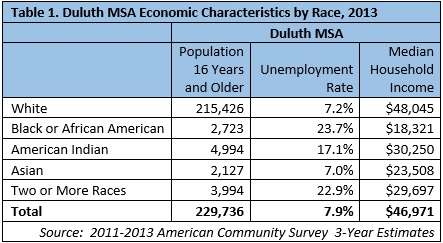 Home to the state's second-largest metro, the Northeast Region has a strong industrial sector, tied largely to the area's abundant natural resources.
Home to the state's second-largest metro, the Northeast Region has a strong industrial sector, tied largely to the area's abundant natural resources.
Most of the manufacturing base centers on mining and forest products industries. More than half of the sector's employment is in paper and machinery manufacturing.
Want the freshest data delivered by email? Subscribe to our regional newsletters.
11/30/2015 10:31:51 AM
Erik White
U.S. Census Bureau data released earlier this fall indicates widening racial disparities in Minnesota. The median household income for Black or African American Minnesotans fell more than $4,500 to an estimate of $27,000 in 2014, the only racial group to see their household income estimate drop during the past year. In comparison, household income for Whites increased more than $2,000 from 2013 to 2014, to a median of $64,000.
In contrast, according to DEED's Alternative Measures of Unemployment in Minnesota, the unemployment rate for Black or African Americans in Minnesota increased from 10.2 percent in September 2014 to 16.0 percent in September 2015. Meanwhile, the unemployment rate for Whites dropped to 2.8 percent, and the overall state unemployment rate fell to 3.8 percent (Figure 1).
Similar racial disparities can also be seen in Northeast Minnesota. Using the 2011-2013 American Community Survey 3-Year Estimates, data show that the Duluth-Superior Metropolitan Statistical Area -which includes St. Louis and Carlton counties in Minnesota and Douglas County in Wisconsin - had considerable differences in income and unemployment rates between the races.
Household incomes are lower in the Duluth MSA for all race categories than they are in Minnesota, but the income gap between whites and non-whites is substantial in the region. Whites had a median household income estimate of $48,045, significantly higher than the average income of $18,321 for Blacks in the Duluth MSA. The unemployment rate for Black or African American was more than three times that of the rate for Whites, 23.7 percent compared to 7.2 percent. Workers of Two or More Races had an unemployment rate 22.9 percent, and American Indians had a rate of 17.1 percent, indicating barriers to employment for the largest minority groups in the region (Table 1).

Addressing this racial inequality has become a priority for Governor Mark Dayton as he has led community forums across the state, engaged business leaders, and created the Office of Career and Business Opportunity housed within DEED with a stated purpose to identify and help break down barriers to employment and business opportunities for people of color. In Duluth, The Council for Minnesotans of African Heritage hosted a community event to discuss the disparities with DEED representatives, the Department of Human Rights, and local politicians.
If Minnesota expects continued economic growth it will need to address these racial disparities, as much of the labor force sustainability will depend on people of color and new immigrants replacing the wave of retirees. According to data from the Minnesota State Demographic Center, from 2015-2030, it is expected that Minnesota's labor force growth rate will be less than an annual rate of 0.3 percent. Due to an even older and more homogenized population in Northeast Minnesota, getting all hands to help and reducing barriers to employment is imperative to future economic success in the region.
Contact Erik White at 218-302-8413.